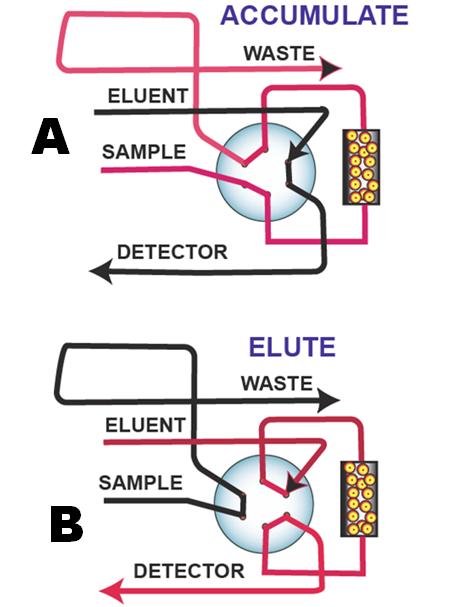Sorbent Extraction for Trace Analysis
1.3.10.
By sorbent extraction technique target analytes are extracted from the liquid phase onto a surface of a solid phase, furnished with an appropriate ligand. The goals of such sample preparation step are:
- To increase sensitivity of an assay
- To separate target analyte from interfering matrix components.
Enrichment of target analyte by extraction on solid sorbent was conceived by Yoshimura and Waki (1985) and demonstrated in their pioneering work on enhancement of sensitivity of spectrophotometric assay of metal chelates. They outlined principal parameters of the method and defined the enhancement of sensitivity from the slope of calibration line obtained by enrichment of the analyzed sample, divided by slope of calibration line computed from molar extinction coefficient Their manually executed batch analysis; achieved up to 1000 times enhancement of sensitivity, by using one milliliter of sorbent suspension equilibrated upon stirring with up to one liter of metal chelate. The sorbent, separated by filtering, was packed into 1 cm flow cell. Next Lazaro et al., (1988) automated sorbent extraction by combining a flow cell packed with sorbent with peristaltic pump. This flow system increased sampling frequency and reproducibility of assay, but was less sensitive than the original batch method. The flow injection platform was combined with sorbent extraction for the first time by Lacy et al. (1990) in a study, where spectrophotometry was carried on solid phase (optosensing) as well as on eluted complex. The use of hydrophobic sorbent (such as silica bound C-18), lets any non-charged, organic compound to be extracted from the aqueous phase. By using organic chelating ligands (ferrozine, hydroxyquinoline, cupferrone, dithizone, etc.) efficient and selective separation of a target metal ion can be accomplished from complex aqueous matrixes.
Quantification of analyte can be performed either by on column by spectrophotometry (Lacy 1990, Miro 2004) or in eluate by spectrophotometry, fluorescence, Atomic Absorption, or ICP.
Automation of SE by Flow Injection is based on analyte accumulation (A), whereby a defined volume of sample is passed trough the column, followed by analyte elution (B). There are many examples of automated sorbent extraction protocols for trace metal analysis for environmental and oceanographic research. (Miro and Hansen 2006, Motomizu 2008) .
The majority of SE methods has been designed to quantify the target analyte in an eluate, while the system is operated in the continuous flow mode. This approach presents several challenges when optimizing the assay protocol because analyte adsorption, analyte elution and system wash are best performed at different flowrates.
Flow programming in Sequential injection mode and the use of lab-on-valve platform discussed in Chapter 3 (Bead Injection Technique) eliminates these limitations (Miro 2008, Horskotte 2016), while programmable Flow injection offers new research opportunities in further development of SE and its application for trace analysis (1.3.14.A.)

Yoshimura K. , Waki H, “Ion-exchanger phase absorptiometry for trace Analysis” Talanta 32, (1985), 345
Lazaro F., Luque de Castro, M.D., Valcarcel M.,“Integrated reaction/spectrophotometric detection in unsegmented flow systems’. Anal. Chim.Acta 214 (1988) 217.
Lacy N, Christian G.D., Ruzicka J., ‘ Enhancement of flow injection optosensing by sorbent extraction and reaction rate measurement” Anal. Chem. 62, (1990) 1482.
M. Miro, W.Frenzel, “A critical Examination of SPE preconcentration with spectrophotometric sensing in flowing streams” Talanta 64, (2004) 294.
M. Miro, E.H.Hansen, “Solid reactors in sequential injection analysis. The recent trends in the environmental field” TrAC Vol. 25.No.3, (2006) 267.
S. Motomizu and T. Sakai “On line sample pretreatment ”in: Advances In Flow Injection Analysis and Related Techniques, S.D.Kolev and I.D. McKelvie Elsevier 2008.
M. Miro , S. K. Hartwell, J. Jakmunee, K. Grudpan, E. H. Hansen “Recent developments in automatic solid-phase extraction with renewable surfaces exploiting flow-based approaches’ TrAC 27 (2008) 749
B. Horskotte, P. Chocholous, P. Solich,” Large volume preconcentration and determination of nanomolar concentrations of iron in sea water using a renewable cellulose 8-hygroxyquinoline sorbent microcolumn and universal approach of postcolum eluate utilization in lab-on-valve system. Talanto 150 (2016) 213.









